Participation Camp 2009, an unconference held at NYU’s ITP, is part of a broader vision of the organizers to position open government at the leading edge of an open organizations movement. For more on open organization Matt pointed me to David Johnson’s work and the Virtual Company movement, vermontvirtual.org.
Matt Cooperrider (@mattcoop on Twitter) – the initiator and main organizer, and Suresh Fernando (@sureshf), and Stephan Dohrn (@sdohrn) – who worked with Matt on the virtual aspects of the conference, share an interest in open collaboration, the intersection of collaboration and technology, and “how practices in this space can scale up to a global level.â€
Matt and Suresh met as a result of their deep commitment to the social venture space (see Suresh’s paper, “On the possibility of an open system mobilization platformâ€).
Stephan worked with Suresh to build the virtual strategy – choosing the tools, and working with the virtual presenters to stream them into the conference and the presenters on site who were streamed out. Stephan and Suresh are part of Radical Inclusion – an international group with 2 people in Germany, one in Seattle, one in London. Suresh is based in Vancouver, and Stephan in Brazil.
Participation Camp was both a global gathering with virtual presenters from India, Netherlands, Canada (Montreal and Vancouver), and the US; and it was an extraordinarily vibrant and focused forum for current issues in New York City and State.
Open Collab
The next step for Participation Camp is an experiment called “Open Collab” – to take the evolving ideas into a persistent space that people can stay engaged in. This is in contrast to traditional conferences that are discrete events. There is already a Participation Camp Wiki. But OpenCollab hopes to explore virtual collaboration processes on a number of levels (Google Wave, perhaps?).
“We see that there is already a healthy movement of self-organized camps and conferences all over the world, but no thread that draws them together. Presumably many of these camps and their participants share common interests and goals, and a desire to contribute their discoveries to a larger pool of knowledge.
There is of course, no shortage of online discussion groups and wikis. While useful, these are no replacement for the energy and excitement generated by real-time interaction. We think that the best way to tie the world’s many camps together is to curate a series of open virtual sessions that anyone can join and be a part of.
Our experiment, with the working title “Open Collab”, begins Wednesday July 15th at 15:00 GMT in our PCamp Skype Chat. We’ll focus on building out this concept and a community to support it. Our long-term vision is to build a solid framework for cross-camp collaboration in time for Spring 2010, when most camps gear up.
PCamp was primarily focused on Open Government, in part because better government is necessary for improved collaboration in the face of shared challenges such as climate change, poverty, and war. Help us take our efforts to the next level.”
This Themes doc gives a a good summary of ideas to take Virtual Participation Camp forward and questions about how to make virtual collaboration more effective. It is an excellent frame for those interested in getting involved with the continuing virtual experiment, “Open Collab.â€
There was a rich integration of virtual sessions into the ITP event with video streams that brought in remote participants from across the globe. The conversations from the Skype group chat are archived here, here, and here. I asked Stephan why he chose Skype over say, CampFire, or even an immersive environment like OpenSim. I mentioned how useful OpenSim had been in creating Virtual HomeCamp for HomeCamp2. But I wasn’t surprised to get the response that simplicity and users’ levels of comfort with different tools were the key factors. Although Stephan mentioned that another Radical Inclusion member, Sofia Bustamante (see Turn Up The Courage), is exploring virtual worlds for collaboration.
I recorded the three sessions I attended at ITP on Saturday: Mark Belinsky’s – audio, Gale Brewer’s audio, and Noel Hidalgo’s audio.
Mark Belinsky: OpenMyCity
The pictures opening this post are from Mark Belinsky’s session on the OpenMyCity project (pic of the session notes on the left and Mark Belinsky on the right). Mark is director of Digital Democracy (@mbelinsky Twitter).
“OpenMyCity is backed by a coalition that formed around the Pioneers conference that took place recently in New York and Amsterdam…The goal of OpenMyCity is to find the best ideas about how to make use of municipal open data by asking citizens and organizations to answer a simple fill-in-the-blank question: “If I knew ___, I could do ___.”
Peter Corbett, CEO of iStrategy Labs (@corbett3000 Twitter), and the creative force behind Washington D.C.’s hugely successful Apps for Democracy, participated in the session (which followed his). Peter (picture above) brought up an interesting hypthetical framework to use an open source dating platform to create resource matching to needs:
“What we are thinking about is how in any given city or country or even globally on the net, there are people who have specific needs and there are people who can provide solutions to those needs. So it’s really sort of like a dating site analogy that we use when thinking about how to match those two for the most efficient outcome.”
Although I missed Peter’s session, I caught up with him for an interview (full transcript below) in which I asked him more about this repurposing of an open source dating platform idea, and the latest developments in Apps for Democracy.
Gale Brewer: New York City’s Open Data Legislation
NYC Council Member, Gale Brewer (@galeabrewer Twitter)
NYC Council Member Gale Brewer’s session on opening government data – Introduction No. 991-2009, gave an important explanation of the Open Data Legislation and why this effort to get raw data to the public legislatively is important (audio here – the recording is not of the highest quality but OK, and I hope to have a transcription soon).
Unfortunately, the Bloomberg administration and the Council are at odds over this now as the Bloomberg administration doesn’t appear to see the immense value of raw data over data packaged in accordance with what an administration thinks people needs (see this post on Gateway to Gov research and Discussion Blog, and John Geraci’s post on O’Reilly Radar, “Open Gov Is a Dialogue Not a Monologue.”)
Mayor Bloomberg, in a Skype appearance at #PDF09, immediately after Participation Camp announced “that NYC would be holding a “Big Apps Competition†in the spirit of DC’s Apps for Democracy” (see my interview with Peter Corbett, DC Apps for Democracy below and these posts on Big Apps – New York Future Initiative and the NYTimes City Room blog).
But, as Gateway to Gov pointed out: “Garnering less publicity, the NYCEDC has issued an RFP for an individual or organization to run this contest. Interest? Register on the NYCEDC’s website or download the RFP directly.”
Samuel Wong (@samjwong Twitter), Legislative Aide on Technology in Government, Office of Council Member Gale A. Brewer, attended Participation Camp (picture above), and is active in the virtual forums. Sam points out that Big Apps is a great idea, but cannot be implemented without open raw data from the government.
In email, I asked Sam what people could do to support the Open Data Legislation and he suggested:
“Right now, we are trying to gather information from other cities that have tried to open up their government – possibly some stats on cost-savings. The administration is worried about this. If people can submit a brief written statement of other cities’ efforts, that’ll be helpful.
As the Administration considers a demand model for NYC Big Apps, the supply side is missing. A top-to-bottom model will be ineffective, in comparison the people-government collaboration model generates a sense of government accountability and trust.
In order to engage and collaborate with the people, the first step is to tap into the unique intellectual capital in New York City that will revitalize the private sector. Once the government data is available, developers will competitively build applications from the raw data, which will help daily New Yorkers find the information they need.
Intro 991-2009 fosters competition among developers by supplying raw data that can be used for many purposes, including education and quality of life issues: the legislation complements NYC Big Apps, as greater results will yield from it. Open data is a public service enhancement.
Thus, in addition to your advice and support, please participate in Apps for Democracy’s NYC Big Apps Ideas Feedback Forum [www.bit.ly/bigideas] to show your enthusiasm for more data for programmers, developers, and the daily New Yorker.â€
Links from other blogs on Open Data legislation below:
http://nyfi.observer.com/politics/182/new-open-data-standards-legislation
http://nyfi.observer.com/politics/208/pdf-bloomberg-announces-big-apps-contest-says-dine-winner
http://personaldemocracy.com/blog-entry/nyc-council-gives-open-data-hearing
“Several notable individuals” participated in the discussion on Open Data which as Lou Klepner noted, in his post, included but was certainly not limited to, Andrew Hoppin (CIO, NYS Senate), Noel Hidalgo (Director of Technology, NYS Senate, ), Steven Clift (Founder, e-democracy.org), Silona Bonewald (Founder, Legal of Technical Voters), and Craig Newmark (Founder, Craigslist.org).”
Craig Newmark (@craignewmark Twitter) brought up some vital questions concerning how we can raise public awareness around the Open Data Legislation. I had a quick chat with Craig after the session. I was surprised and happy to see him playing such an active role in a small unconference.
Tish Shute: I noticed Gale Brewer was very enthusiastic just now about some of your recent work -Â there was a boot camp I think? What is that?
Craig Newmark: Something that the Craigslist foundation does is to run a boot camp. The idea is to help people who want to help to be more effective at it. Focusing on non-profits. For example, last week one theme was to help people present what they’re doing more effectively. Because if you don’t – if you can’t tell someone what you’re doing in 30 to 60 seconds, they’re going to start tuning out. There’s also grant writing issues if you’re a foundation or a non-profit of some sort. And then there’s the effective use of technology. The idea is that if the bootcamp can help give someone a clue about any of those, that can make life much easier for someone who’s trying to help other people.
There is a nice short video here about Craig Newmark’s commitment to Gov 2.0, also see his blog.
Andrew Hoppin and Noel Hidalgo: nysenate.gov
Andrew Hoppin (@ahoppin Twitter) – pic above, was an active contributor to the discussion on OpenData. His team seems to have survived the upheavals in Albany to continue their innovative work on nysenate.gov that now allows “constituents to give direct feedback to Senators on proposed bills, hearings and issues in “crowdsourcing portals” for property taxes, ethics reform and campaign finance,”(see here for more, and also see my post on the work of Nathan Freitas the great developer for this team).
Director of Technology, NYS Senate, Noel Hidalgo (@noneck Twitter) – picture below, led the excellent session on nysenate.gov (audio here).
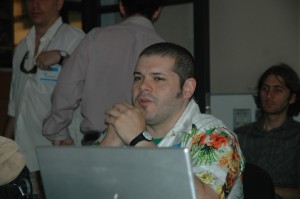
More on Virtual Participation Camp
This week I got a chance, through the PCamp Skype group, to follow up with Suresh, Stephan and Matt (picture above of Matt Cooperrider participating in Gale Brewer’s session). One of the topics I was interested in hearing more about was the Twitter and Iran Workshop that was part of the ITP program. Unfortunately I wasn’t able to attend in person.
I was interested in following up on some of the issues raised in my previous post, Twitter and The Web of Flow: Talking with Stowe Boyd & Bruce Sterling about Microsyntax, Squelettes, Favela Chic and the State of Now.
Matt noted that the centralized hijacking was taken as a given and the question was:
1. how do we get more reports out despite that
2. how do we aggregate/filter those reports
But, he also noted, the group at hand was less interested in a specific solution and got philosophical pretty quickly. What is our goal with these interventions? To support people’s right to democracy?
Matt explained:
“I was pushing a project described here: http://votereport.pbworks.com/Iran-Election but the more experienced folks seemed to think it was too late for a solution like that but everyone pretty much agreed that the main goal was to get something like that ready for the “next one:” someone, Noel I think, suggested an international ICT “Red Cross” style organization.”
One of the virtual presenters at Participation Camp was Gaurav Mishra (@gauravonomics Twitter), the founder of 20:20 Web Tech, Votereport.in, and a leader in India’s Gov2.0 scene.
Stef Van Grieken (@stefvangrieken), New Voting Foundation also presented on the use of electoral compasses to identify key candidates for parliament in the Netherlands.
“The application matches candidates to voters based on the party program’s and individual political views.”
Ed Pastore (@epastore), Metagovernment, delivered a talk entitled, “Making Direct Democracy Practical,†outlining the drawbacks of representative democracy in various contexts; and exploring the historical criticisms of direct democracy and detailing, “several emerging projects which are actively working to overcome the limitations of direct (or otherwise more inclusive) democracy by applying sophisticated web technologies.”
And, Gabriel Flacks, Newsactivist and teacher at Champlain College in Montreal, Quebec, gave a talk entitled “Teaching Participation: the Newsactivist Curriculum.”
Talking With Peter Corbett
Tish Shute: What do I think are the most important apps for democracy to come out so far?
Peter Corbett: Well I won’t say what the most important are, because I think all of the ones created in the first round last year and the ones that are being developed now are important in some way shape or form. I’ll say what the most interesting were, and which were the ones that won medals.
So “ilive.at” won the gold medal in Apps for Democracy last October. What it does is, you put in your address and it basically forms the world around you. And you can see where crimes happened and where the post office is, and where the grocery store is. It’ll also show you an overlay of U.S. census data, to show you sort of the composition of that neighborhood – so what’s the average age, what’s the ethnicity, the composition from a married/single perspective.
The city thought it was really great and that it could help people decide where to move, and what that place looked like if they were in a certain sector of the city. Another really interesting application that was developed was “We the People Wiki,” and if you go to wethepeoplewiki.com you can see it. What it does is it creates all in one place all the information around crime you can imagine for a specific case. So if there was a homicide, you can see who the community prosecuter is, who the defender is. You can see the ward within which it happened mapped, the specific address where it happened mapped. Also realtime data will stream up showing the last 5 homicides in that area – trying to identify, “Are there some trends around this thing, etc.?” So those are two interesting cool apps that were created.
In this new edition, Apps for Democracy “Community Edition, amongst the applications we’ve seen entered, there’s one that is essentially an iPhone application that lets you walk around the city and geolocate yourself so it’ll show you you’re on this street corner and you can take a picture of a pothole, upload it to the 311 service request system, and then hit “send to facebook,” and it publishes to your social profile, and people see that you’re concerned about this stuff. And what that does is it creates little social hooks to get your friends to say, “Oh I can do this too and I should do this too.” So we start to build a better view of what the problems are in the city, so that the city can then take care of them.
I think the promise of something like that is building an additional layer on top of it later, maybe where citizens would be empowered to solve some of these problems themselves. Because some of the things that get entered won’t really be things the city can take care of. Certainly litter is within the perview of the citys’ responsibility, but could there be community organizations who take care of things like that if you start to see trends in certain places of having a lot of requests around that.
There’s a last application I’ll talk about in this community edition, it’s called “PointAbout”. What it does is it builds an interactive map of all the vacant properties in the district which happen to be havens for drug abusers and possibly dangerous areas at night and things like that. Building that is really important. It’s really hard right now to do that in the city because it’s a lot of footwork and paperwork. So citizens themselves can identify addresses when they’re out and about and say this is a vacant property. It’ll make DC a safer place.
Tish: So have you seen the Sprx Mobile app “Layar,” an augmented reality browser?
Peter: I have seen that. It’s very cool. I think augmented reality is A the present and B the future. So it’ll be very cool to see augmented reality applications developed for DC in the future. Or anywhere, I’m very DC centric obviously. I live there and DC’s my client.
Dimitry Kachiev who’s the director of research and development for the city of Washington DC, just released an API actually that will show you in realtime the location of DC’s circulator buses. The circulator buses only go inside DC and are therefore not owned and operated by WAMATA which is metropolitan area transit authority, which won’t release their realtime data. So looking at Google Earth you can literally see the buses moving around the map. I use the circulator. I live 5 blocks from the line, but I never know when to leave my building to go to it. And now I can go, “Oh I see bus number 1150 is 5 blocks down, I might as well start walking now. Because then I’ll intersect it.”
There’s no live application. There’s just a data feed. But it can be visualized on Google Earth. And if you go to api.dc.gov you’ll see the beta API for that feed. So then you just click it, load it into Google Earth, and you’ll see the busses moving around.
Tish: I was fascinated by the idea you mentioned to use an open source dating platform to create resource matching to needs. But I didn’t quite pick up whether you actually built something yet?
Peter: No that is a hypothetical framework that we haven’t really put to the test yet. What we are thinking about is how in any given city or country or even globally on the net, there are people who have specific needs and there are people who can provide solutions to those needs. So it’s really sort of like a dating site analogy that we use when thinking about how to match those two for the most efficient outcome.
So think about males being people who have needs maybe females as being providers or something. So when you login and create your profile, you say I can provide this stuff. I’m a web developer, I’m a designer, I’m a great carpenter, I can transport food to places. and then what the needs are. We need food, we need web design, we need whatever, here’s our location. I’m not currently married, I’m single. So going into the system an algorhythm would say OK based on the need, and based on the provider, Peter Corbitt should provide web design to this non-profit because A it’s 2 blocks away from him, B he’s not on a project right now, C they’re not currently being satisfied with that need. Matched.
Tish: How is that different from what Mechanical Turk’s doing other than the payment thing?
Peter: I think there’s a lot of differences. Mechanical Turk is really just paying for specific actions in a discrete period of time. I want ten thousand people to click this link ten thousand times.
So the dating site analogy is extended when assuming that this need is fullfilled there was a discrete need like we just need 20 loaves of bread, well great done that need is gone. The need is gone out of the system, the matching doesn’t happen again. But if it’s an ongoing need like elderly care or afterschool tutoring, when that marraige is broken, when there’s a divorce, that needer goes back into the matching system to be rematched. Everywhere it happens, someone has a volunteer for a specific thing at a non-profit, they lose that volunteer, they have to go back and get a new one and it’s just an ongoing process. If you automate that it’ll be much more efficient. You’ll get more done.
Tish: How is that different from what the The Extraordinaries does?
Peter: The Extraordinaries concept I think is similar to a certain extent. The concept is very cool. So the it’s probably a little synonymous.
Their concept is a mobile micro volunteering thing, which is terrific. And I look forward to using it. I don’t know yet that they’ve gotten their application developed and approved?
Tish: You work for a very busy marketing company, how do you fit this all in? Where does it all fit? How do you monetize it? How do you keep it together?
Peter: Sure. I’m the CEO of iStrategy Labs, and 95% of our revenue comes from brands like Geico, American Eagle Outfitters, Rockstar folks like that, that pay us to do cool weird things with marketing technology. The D.C. government is our client, and pays us to create cool new things like apps for democracy.
Tish: So the D.C. government pays you to do Apps for Democracy?
Peter: That’s right. So we created the concept, and execute it and run it and champion it. Apps for Democracy is a way to engage citizen technologists in building applications for their city, by incentivising them with a little bit of fame, and a little bit of fortune.
Tish: But it’s basically D.C. based?
Peter: Nope. Yes and no. It’s focused on applications for the city of Washington D.C. The first round that we had last year, 80% of the applications were developed by D.C. based people, I should say the greater D.C. area so D.C., Maryland, Virginia. The other 20% came from California, Massecussets, North Carolina, from specific hackers that like to work on this kind of stuff. There’s an Apps for Democracy Finland, there’s an Apps for Democracy Belgium. It’s spreading as an idea, as a way to do things differently. And those aren’t paid consulting engagements that we have for iStrategy Labs.
I give that insight away freely because I want people to do it. I think it’s the right way to do things. And it certainly helps our initiative be more well known and give us more impact when we do something.
Tish: And you mentioned you’re very involved with Government 2.0 camps and O’Reilly’s upcoming Government 2.0 Expo, and Government 2.0 Summit?
Peter: I’m on the programming committee for Government 2.0 Expo. Government 2.0 Summit I just sort of help promote a little bit. Government 2.0 Camp I co-created with 3 other individuals, and Government 2.0 club I co-created, and Transparency Camp.
Game Play and Collaboration
A collaborative sculpture (pic above) emerged at Participation Camp, also a game of Nomic
“Nomic is a game in which changing the rules is a move. In that respect it differs from almost every other game. The primary activity of Nomic is proposing changes in the rules, debating the wisdom of changing them in that way, voting on the changes, deciding what can and cannot be done afterwards, and doing it. Even this core of the game, of course, can be changed.”
—Peter Suber, the creator of Nomic, The Paradox of Self-Amendment, Appendix 3, p. 362.
Also there was a linkcube unit stationed at ITP throughout the conference, but unfortunately I didn’t have a moment to check it out. Linkcube is part of the 80+1 project.
“Using real-time data exchange, the users, who are geographically distant, are presented on screen as if they were right next to each other. This closeness lets users get momentarily acquainted with other humans to whom they would not otherwise be exposed. What results is a set of playful interactions and the ultimate photographs serve as a tangible record of this memorable virtual experience.”

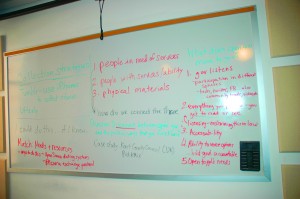
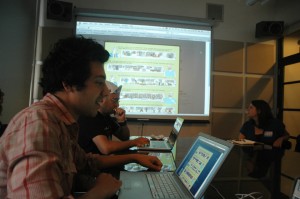
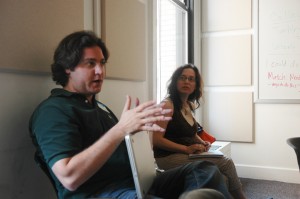
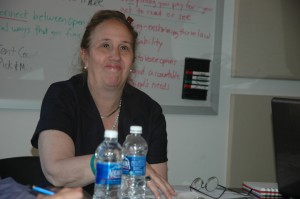
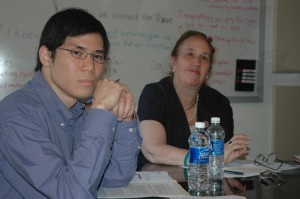
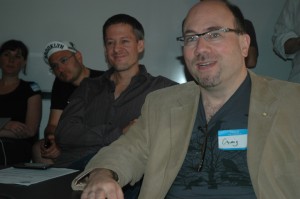
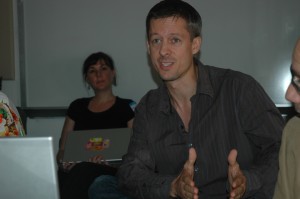
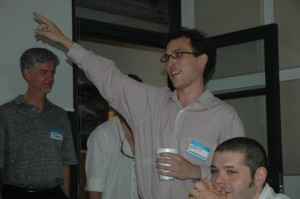
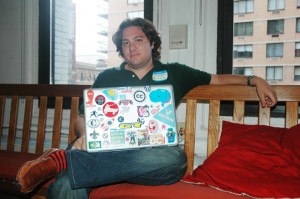

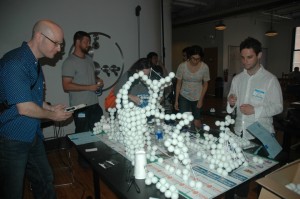
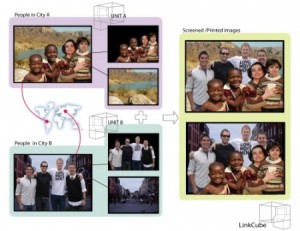
July 10th, 2009 at 12:16 pm
Great summary! It’s baby steps at times, but progress is being made. BTW, tomorrow at 5AM PST/Noon Ghana time there’s a special #obamaghana speech being made available for discussion in Second Life (tinyurl.comSLObamaGhana) and Metaplace.com/Interval with speakers to include diplomats and ambassadors, educators and Ghanian leaders here in the US — join the Public Diplomacy group inSL for future updates.